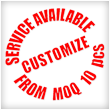Torsion Spring
TORSION SPRINGS are helical springs that exert a torque or rotary force. The ends of torsion springs are attached to other components, and when those components rotate around the center of the spring, the spring tries to push them back to their original position. Although the name implies otherwise, torsion springs are subjected to bending stress rather than torsional stress. They can store and release angular energy or statically hold a mechanism in place by deflecting the legs about the body centerline axis.
This type of spring is normally close wound but can have pitch to reduce friction between the coils. They offer resistance to twist or rotationally applied force. Depending on the application, torsion springs can be designed to work in a clockwise or counter-clockwise rotation, thus determining the direction of the wind.

CSB Spring & Hardware Sdn Bhd manufactures custom torsion spring in different types and configuration to suit your specifications on affordable minimum order quantity of 10 pcs
Applications
Common torsion springs are used in clothes pins, clipboards, swing-down tailgates and garage doors,. Torsion springs are used for hinges, counterbalances and lever return applications. Sizes range from miniature, used in electronic devices, to large torsion springs used in chair control units. Load should be applied in the direction of wind; unwinding from the free position is not recommended. As they wind up, torsion springs reduce in diameter and their body length becomes longer. This should be considered when design space is limited. Torsion Springs perform best when supported by a rod or tube. The designer should consider the effects of friction and arm deflection on the torque.
 Figure 1 DIRECTION OF WINDING
Figure 1 DIRECTION OF WINDING
Configurations
Torsion springs are designed and wound to be actuated rotationally, and to provide an angular return force. There are many options for leg configuration so the spring can be attached in different ways. Leg specifications to consider for torsion springs include leg angle, equal leg length, and leg end style. Springs that are straight or parallel on the same side are considered to have a 0º leg angle the increasing angle is in the unwinding direction. Leg end style choices include straight torsion, straight offset, hinged, short hook ends, and hook ends. Torsion spring ends can be bent, twisted, hooked or looped to suit your project needs
The double torsion spring consists of one set of coils coiled right hand and one set of coils coiled left hand. These coils are connected, usually with an unwound section between the winds and work in parallel. The sections are designed separately with the total torque being the sum of the two.
 Figure 2 ENDING STYLE
Figure 2 ENDING STYLE
 Figure 3 ENDING DEGREE
Figure 3 ENDING DEGREE